Imagine you are at a sports game and you hear the crowd screaming for their team. Then, you listen to people chanting your name and suddenly you feel the goosebumps of excitement cover your skin. Being an athlete, this feeling is what gets your adrenaline pumping to play the game that brings you happiness and showcases your talent. However, being incapable of doing so from a severe injury is one of the hardest challenges an athlete faces especially when returning back to the sport that made them who they are.
One of the most common injuries athletes’ experiences is tearing their Anterior Cruciate Ligament also known as an ACL. This tear occurs either by a collusion from an opponent or a non-contact incident. Each injury is different because there is either automatic response that the ACL has been torn or a loud pop heard that leads to excruciating pain. ” The ACL acts as a passive constraint on the femurs anterior tibial translation and has mechanoreceptors. The receptors perform as messengers that send information to sensory pathways that result in the reflex of the hamstring and provide protection for the dynamic stability of the knee” 1
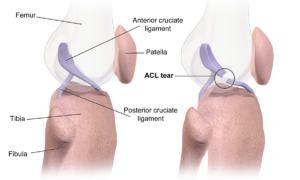
Date: 3 November 2015
Source: Courtesy of Wikimedia
Author: Bruce Blaus
Once the ACL is damaged, athletes experience is as if their knee is not under control and prevents putting weight down on the leg. This is a frightening incident that requires surgery which can impact day to day activities. There is uncertainty felt by patients with surgery based on the doctor’s preference and what they believe is the most effective. The most common two surgeries performed on athletes are Quadriceps Tendon Autograft and Hamstring Tendon Autograft. Both methods require excising tissue from somewhere else in your body and utilizing it to create a new ACL. Then one week after recovery from the surgery, it is back to square one which is rebuilding your strength back.
Physical therapy is known to be the hardest task people face. I was told by my teammates who also tore their ACLs that it is all mental. Anterior Cruciate Ligament injury is considered debilitating and has long term negative consequences. When I first experienced my injury, I had excruciating pain and lost the ability to control movements in my knee. That feeling frightened me, and it was hard for me to come to terms that my knee was never going to be the same. It not only made me feel physically exhausted but mentally since I was told that soccer is not my number one priority.
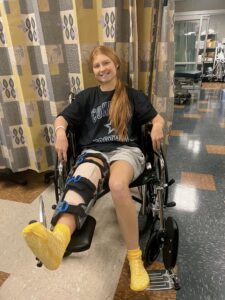
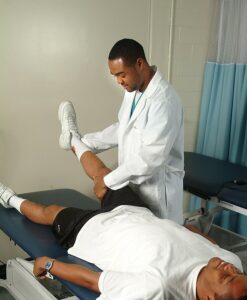
Date: 9 September 2004 Source: Courtesy of Wikimedia
Cooper Kupp was fortunate to have torn only his Anterior Cruciate Ligament but, for some athletes there are the opposing issues that can push back an athlete from being in a positive state of mind to negative automatically. During my recovery I had faced the challenge of having yet another surgery, which is common with most recent ACL surgeries known as Arthrofibrosis. This condition causes the formation of scar tissue to build up within the joint during the time span of ACL reconstruction surgery. This setback can cause the return to sport (RTS) process to take a longer period of time. The importance of this surgery is to regain the range of motion back in your knee and to not maintain anymore stiffness. ” This degree of fascia engagement explains a limbs restriction of range of motion and indicates manual therapy to be helpful for rehabilitation” 5
After several months of physical therapy later, it should be finally the moment to hear the news of returning back to your sport. There is the feeling of relief of finishing therapy but then the negative internal thoughts start to develop. There is the thought process questioning whether or not you, as an athlete are prepared to participate in an intense environment again. This leads to the option doctors give their patients whether to brace or not. Some doctors have it as a requirement but after a period amount of time it becomes the patient’s choice. It can be difficult to decide because this deals with the relationship between your own self confidence versus the injury.
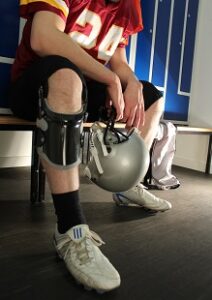
Source: Courtesy of Wikimedia
Date: 9 January 2015
” Self-confidence is thought to be important factor in pre-competition preparation with potential side effects on focus, self-efficacy, tension, depression, anger, fatigue, and confusion” 6 Not only do these variables affect training but also the feeling of not failing, pressure and coaching. Internal and external factors influence facilitating either success or failure. The breaking point of an athlete’s career is self-doubt in their physicality and fearing re-injury. That is why bracing is a major decision because it dictates whether you feel a sense of safety and comfort when cleared to go back. Bracing can be perceived as negative, but it is an actually a positive reinforcement.
Additionally, going through the protocols of returning to sport after an Anterior Cruciate Ligament surgery requires taking several tests. Such as physical examination, strength, range of motion, vertical, and dynamic stability. In the journal article “The Development of a Return to Performance Pathway Involving a Professional Soccer Player Returning from a Multi-Structural Knee Injury: A Case Report” the article illustrated ” The first priority in the return to sport decision should be the patient’s health and safety, but contextual factors may also influence the timing of return to sport” 7 It is essential to ease into a sport cautiously to minimize the risk of re-injury and to make certain to be at the best levels of your health. That is why the test taking is crucial in order for the doctor to evaluate any repercussions. The hardest test that athletes have is the tendency to fail is psychosocial assessment. It is hard to trust your body once again after facing the outcomes of it failing. Several doctors include this assessment to understand their patient’s mentality. In some cases, if still struggling with the aspects of feeling prepared, some doctors or schools require sports physiotherapy or sports therapy. Physiotherapists are defined as the treatment of injury by physical and mechanical means. ” This system of training allows for greater breadth and depth of preparation combined with specific topics applicable to sport, and the care and prevention of sports injuries” 8. When going to a sports therapist, it is useful to have someone who can listen to what you are experiencing and can relate since they may have encountered the same dilemma. Mental health is a sensitive topic that is not taken as seriously as it should. That is why it is extremely important for subject to deal with to get athletes back to playing with a positive and well minded mentality.
An injury is a long journey that requires an abundance amount of hard work to get back to the level you were at before. It is crucial to follow the instructions of your doctors or physical therapist to enhance your physical and mental health. I have had such a challenging journey overcoming my injury and it has encouraged me to keep pushing through all of the pain I have had mentally and physically. I believe it is crucial for athletes to seek psychological help in order for patients to release the emotions spiraling their head and hear reassurance. It is a hard process; however, when reaching your goal, it will be all worth it in the end. That feeling of passion for your sport will be rushing back and you will gain a sense of pride in the accomplishment you made.
- Patil Deepali, et.al. Rehabilitation of ACL Reconstruction: A Research Protocol (June 6, 2023): 1. ↵
- Piussi Ramana, et.al. Psychological impairments after ACL injury: Experiences from sports physical therapist, (March 7, 2021): 1509. ↵
- David Mechanic, Role Expectations and Communication in the Therapist- Patient Relationship, University of Washington: 190. ↵
- Los Angeles Rams, Inside Cooper Kupp’s Rehab After Tearing His ACL in 2018, (April 24, 2020) 1:26. ↵
- Brandi Higbee, et.al. Hypothesized Biotensegral Model for Scar Tissue, (January 1, 2023):112. ↵
- Hannah Arnett, “Relationship Between Bracing after Injury and Perceived Sport Confidence Among Guilford College Athletes: A Retrospective Study, “December 8, 2021): 5. ↵
- Meredith J. Sean, et.al, Return to sport after anterior cruciate ligament injury: Panther Symposium ACL Injury Return to Sport Consensus Group, (February 6,2024): 2410. ↵
- James E. Zachazewski and David J. Magee, Handbook of Sports Medicine and Science: Sports Therapy: Organization and Operations, (November 5, 2012): 2 ↵
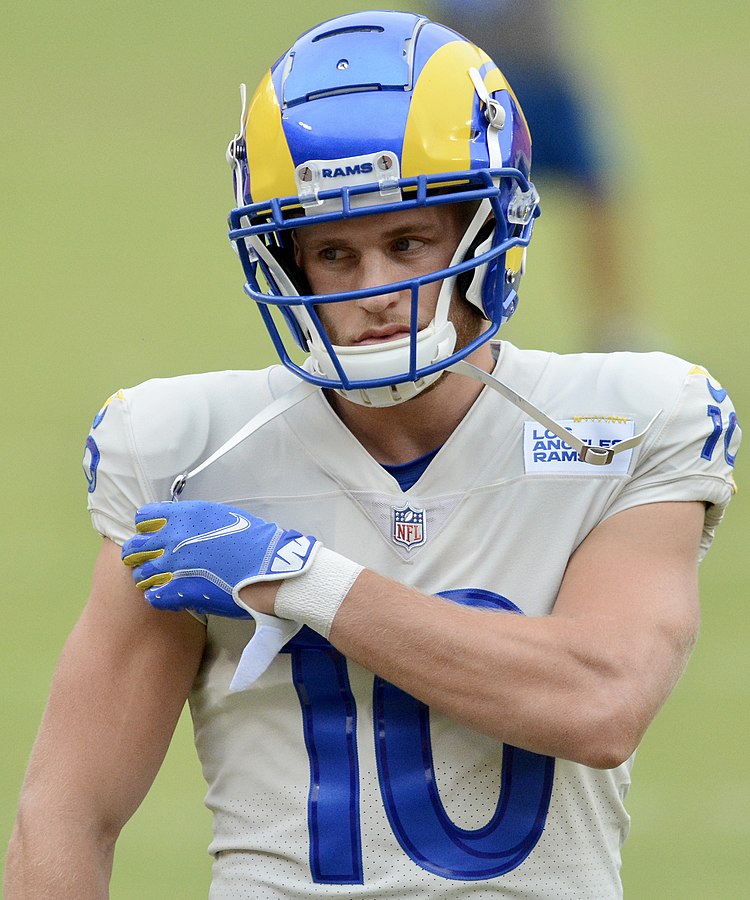


6 comments
Sebastian Hernandez-Soihit
Very interesting article and I do appreciate that there is an element of personal life situations to its narrative. Sports are a very demanding and often unforgiving vocation that can definitely put one’s mental endurance to the test- the accounts you shared demonstrate it.
Stela Naomi Sifuentes
There’s something truly special about the energy and atmosphere during a comeback in sports. Comebacks in sports are the ultimate test of character. They reveal the true grit and determination of athletes, showing us what they’re made of when faced with adversity. It’s in those moments of struggle that champions are truly born.
dandrews2
Hi Kendall,
I really enjoyed reading your article. As someone who was once an athlete and faced severe injuries, it is nice to read about an article that delves into an athlete’s injury and path to recovery. Not only do you help the reader understand the injury, but you also walk them through the rehabilitation path and the physical and mental toughness it takes to follow through. As someone who can relate to this, it is nice to see this kind of writing put to words and put together so skillfully.
Jonathan Flores
This article is very interesting and I commend thee ability to insert your own experiences into this topic and offer your own insight. This article affirms many of the thoughts I have had in the past regarding serious injuries and offers valuable information into the psychological effects of injuries too. As someone who has also gone through a serious sports injury, this article was particularly pertinent.
Ana Barrientos
Hi Kendall, I enjoyed the way you compared your ACL tear and Cooper Kupp’s. It gave me a better understand that each injury is different for everyone. I also felt like you incorporating your own experience with an ACL injury gave us a first person view of how stressful and frustrating they can be and even how much of a toll they can really take on someone. Overall, great job!
Eugenio Gonzalez
Hello Kendall, I enjoyed reading your article and I like the incorporation of the first image as it helps readers visualize an ACL injury. The article does a good job of demonstrating Cooper Kupp’s mindset in overcoming such a significant injury and coming back stronger than ever. I appreciate how the author highlights the process of rehabilitation and how Kupp’s discipline in rehabilitation helped him overcome all mental and physical struggles.